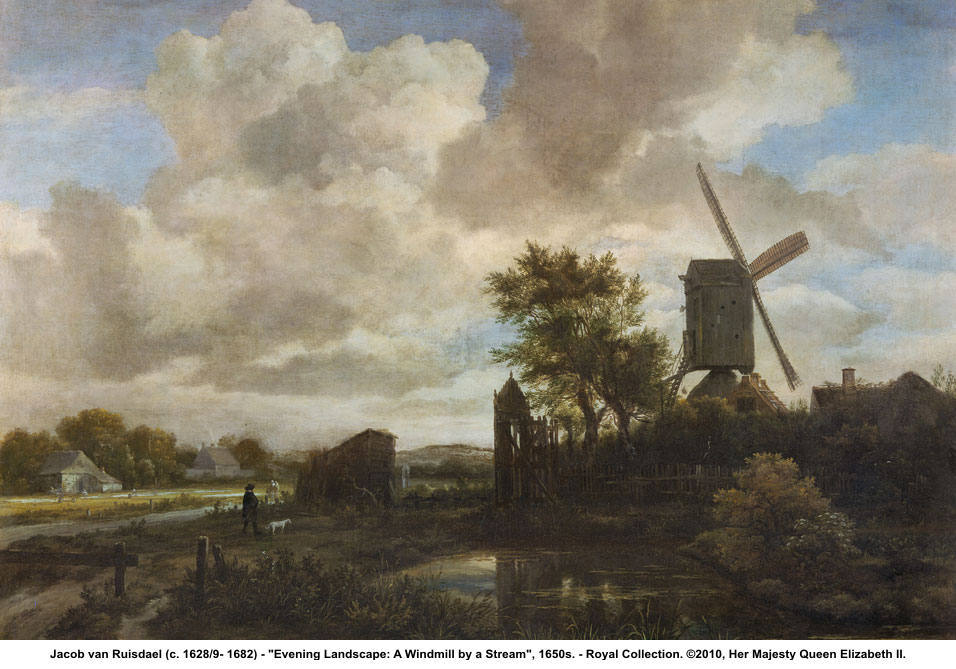
The big event this year at the Queen’s Gallery in Edinburgh is an exhibition of Dutch Landscapes. Van Gogh fans will be disappointed, as these paintings are exclusively 17th Century – and rightly so, as it is in the work of this period that the art of landscape painting actually originated. Formerly a peripheral element to the action in what were usually either religious or mythical narratives, the landscape would step forward to take centre stage in Dutch art in the immediate aftermath of the Netherlands’ liberation from Spanish rule in 1648.
The new Dutch republic became a fertile land for a generation of aspiring artists, the most illustrious of whom are of course Vermeer, Rembrant and Franz Hals. Sadly, none of these painters is represented in this show, but alongside them in the pantheon of great Dutch painters of the era we might find Jacob Van Ruisdael, who is here. His work is often charged with being a transformative influence upon John Constable. When the English painter saw in 1821 Van Ruisdael’s Evening Landscape: A Windmill by a Stream (mid-1650s, see above) he was particularly drawn to the ‘acres of sky expressed’ in the painting. The sky in question is a vigorous accumulation of cumulus clouds looming behind a windmill, a track and a canal, settled in a flat, leafy and gently lit landscape. It is easy to read the influence in Constable’s work.
I am also a landscape painter, though hardly Constable, and so I take a particular enjoyment in scrutinizing paintings like this. An appealing feature of the work in this exhibition is the quality of light that the artists capture. It is for the most part a soft, warm light, the light of a late summer afternoon. Some of the paintings are by the group of Dutch artists who travelled south to Italy where they came together, in Rome, as the ‘Bentveughels’ (‘birds of a flock’). Some of the work they produced here is as much soap opera as landscape, especially Johannes Lingelbach’s Figures Before a Locanda, with a View of the Piazza del Popolo, Rome, which is a wonderful depiction of a group of bawdy, somewhat squalid characters engaged in various dubious tasks with a distant backdrop of classical architecture. This painting, rendered with an almost filmic intensity and accuracy, sums up something of the Dutch painters’ ambivalence to Italy: the land of classicism and the Renaissance now betrayed somewhat by the grim state of modern life.
The majority of the landscapes in this exhibition are, however, set in the Netherlands rather than Italy, and many of them are maritime scenes. The sea was enormously important to the Dutch republic; it owned an astonishing proportion (nearly half) of Europe’s merchant shipping in the mid 17th century, and this devotion to the sea is apparent in the painting. A Calm: A States Yacht Under Sail Close to the Shore by Willem van de Velde the Younger is typical. There is an interesting quality to tonality, highly controlled yet naturalistic, and the delicate accuracy of the vessels recalls Canaletto. The ships crowd the painting, jostling on the sea, their jagged masts and triangular sails accumulating like the sweeping abstracted motifs of cubism.
The land-based painting is defiantly rustic: peasants, farms, animals. This work would have been shocking at the time, vulgar indeed, and at times it seems to play up to its own reputation. There is a humour in some of these works that we would not usually associate with ‘landscape’ painting. Paulus Potter’s Two Sportsmen Outside an Inn shows a pair of hunters (a wealthy man and his servant) on horseback, seeking refreshment at a wayside inn. The status of the characters involved is carefully and definitively drawn out: the innkeepers share their dwelling with a pig, their jugs are cracked, their feet are bare. The rich man is finely dressed, his horse handsome. The superiority of the travellers is undercut a little by servant’s horse, which is taking a long piss, and the huntsman’s spaniel, indelicately sniffing the innkeeper’s mutt. Potter’s Young Thief delighted my companion (aged four) who probably identified with the motives of the protagonist, a small child attempting to abscond with a puppy but caught at once by the mother dog. Again, the landscape is not at the centre of this painting; like the Sportsmen, this painting has a narrative focus. Nevertheless the landscape we see is treated with reverence and used not as merely filler but as an integral part of the composition. The event is occurring within a very definite environment, and so the landscape has its own importance. Paulus, who is justifiably well represented in this exhibition, also does a good line in characterful cattle and heavy, portentous skies.
If these works might look to our modern eyes somewhat sedate, clichéd, or even the dreaded term ‘chocolate box’ (when did chocolates last come in such a box?), then it is only because in the near 400 years since they were painted we have been treated to the extraordinary visual dissections of the landscape as rendered by all those from Turner and Delacroix to the Impressionists and Expressionists of modern times. It is easy to forget that these artists, and all others whose eyes turn to the landscape around them, tread a path initially laid out by the likes of Van Ruisdael and his contemporaries.
Dutch Landscapes
The Queen’s Gallery, Palace of Holyrood House, Edinburgh
Until 9th January 2011






Comments